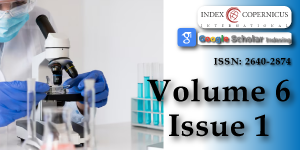Post-operative agranulocytosis caused by intravenous cefazolin: A case report with a discussion of the pathogenesis
Main Article Content
Abstract
A case of post-operative agranulocytosis which occurred in a 66-year-old woman following surgery for endometrial carcinoma is reported. The agranulocytosis had a rapid onset, being detected on the first post-operative day. The causative agent, cefazolin was given to the patient intraoperatively. The agranulocytosis persisted until the 22nd postoperative day. A bone marrow biopsy performed on post-operative day four showed a left-shifted myeloid maturation pattern but not a maturation arrest. The pathogenesis of drug-induced neutropenia/agranulocytosis is discussed. It is postulated that reversible binding of cefazolin to albumin accounts for the prolonged duration of agranulocytosis.
Article Details
Copyright (c) 2022 Lombard CM, et al.

This work is licensed under a Creative Commons Attribution 4.0 International License.
Andersohn F, Konzen C, Garbe E. Systemic review: Agranulocytosis induced by nonchemotherapy drugs. Ann Internal Med 2007; 146: 657-665. PubMed: https://pubmed.ncbi.nlm.nih.gov/17470834/
Uetrecht J, Naisbitz DJ. Idiosyncratic adverse drug reactions: Current concepts. Pharmacol Rev. 2013; 65: 779-808. PubMed: https://pubmed.ncbi.nlm.nih.gov/23476052/
Curtis BR. Non-chemotherapy drugs-induced neutropenia: Key points to manage the challenges. Hematology Am Soc Hematol Educ Program. 2017; 2017: 187-193. PubMed: https://pubmed.ncbi.nlm.nih.gov/29222255/
Rattay B, Benndorf RA. Drug-induced idiosyncratic agranulocytosis-infrequent but dangerous. Fronti Pharmacol. 2021; 12: 1-13. PubMed: https://pubmed.ncbi.nlm.nih.gov/34483939/
Smith CR. Cefotaxime and cephalosporins: Adverse reactions in perspective. Rev Infect Dis. 1982; 4: S481-S487. PubMed: https://pubmed.ncbi.nlm.nih.gov/6294802/
Murphy MF, Metcalfe P, Grint PCA, et al. Cephalosporin-induced immune neutropenia. Br J Haem. 1985; 59: 9-14. PubMed: https://pubmed.ncbi.nlm.nih.gov/3882133/
Cimino C, Allos BM, Phillips EJ. A review of beta-lactam-associated neutropenia and implications for cross-reactivity. Ann Pharm. 2021; 55: 1037-1049. PubMed: https://pubmed.ncbi.nlm.nih.gov/33215507/
Murphy MF, Riordan T, Minchinton RM, et al. Demonstration of an immune- mediated mechanism of penicillin-induced neutropenia and thrombocytopenia. Br J Haem. 1982; 55: 155-160. PubMed: https://pubmed.ncbi.nlm.nih.gov/6882683/
Uy N, Thiagarajan P, Musher DM. Cephalosporin site chain idiosyncracies: A case report of ceftriaxone-induced agranulocytosis and review of literature. Open Forum Infect Dis. 2015; 2: ofv007. PubMed: https://www.ncbi.nlm.nih.gov/pmc/articles/PMC4438888/
Moeschlin S, Wagner K. Agranulocytosis due to the occurrence of leukocyte- agglutinins. Acta Haem. 1952; 8: 29-41. PubMed: https://pubmed.ncbi.nlm.nih.gov/12985212/
Decroix MO, Zini R, Chaumeil JC, Tillement JP. Cefazolin serum protein binding and its inhibition by bilirubin, fatty acids and other drugs. Biochem Pharm. 1988; 37: 2807-2813. PubMed: https://pubmed.ncbi.nlm.nih.gov/3395358/
Vella-Brincat JWA, Begg EJ, Kirkpatrick CMJ, Zhang M, Chambers ST, et al. Protein binding of cefazolin is saturable in vivo both between and within patients. Br J Cin Pharm. 2007; 63: 753-757. PubMed: https://pubmed.ncbi.nlm.nih.gov/17223858/
Zorzi A, Linciano S, Angelini A. Non-covalently albumin-binding ligands for extending the circulating half-life of small biotherapeutics. Med Chem Commun. 2019; 10: 1068-1081. PubMed: https://pubmed.ncbi.nlm.nih.gov/31391879/
Getta B, Ponnian G, Ling S. Intravenous immunoglobulin induces short-term reversal of drug-induced autoimmune neutropenia." Letter to editor. Transfus Med. 2015; 25: 347-348. PubMed: https://pubmed.ncbi.nlm.nih.gov/26192766/
Jacob S, Rajabally YA. Currant proposed mechanisms of action of intravenous immunoglobulins in inflammatory neuropathies. Curr Neuropharmacol. 2009; 7: 337-342. PubMed: https://pubmed.ncbi.nlm.nih.gov/20514213/
Norris PAA, Kaur G, Lazarus AH. New insight into intravenous immunoglobulin mechanisms and alternatives in autoimmune and inflammatory diseases. Curr Opin Hematol. 2020; 27: 392-398. PubMed: https://pubmed.ncbi.nlm.nih.gov/32868670/





